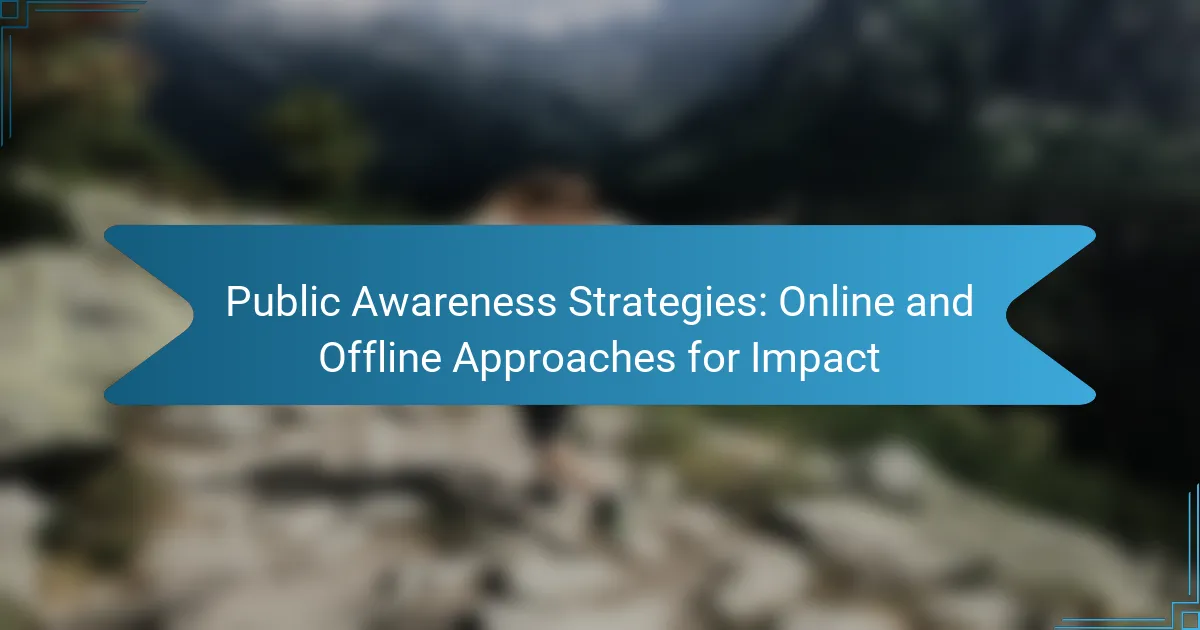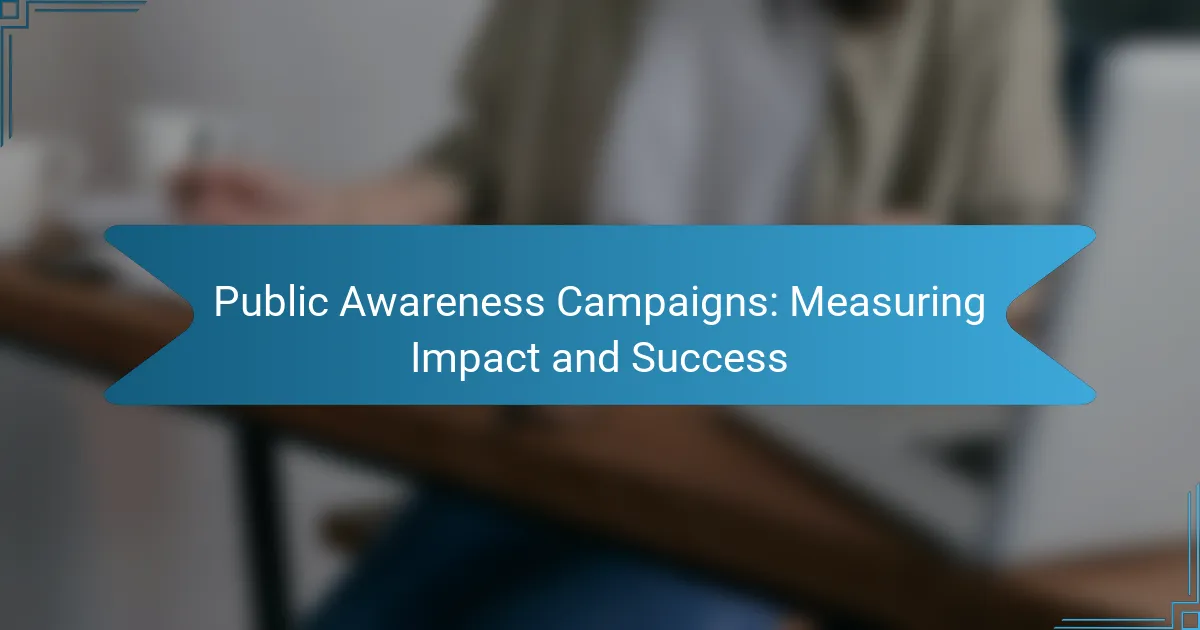In the UK, successful human rights campaigns hinge on cultural sensitivity and robust community engagement, which are essential for building trust and ensuring that messages resonate with diverse populations. By employing innovative outreach methods and fostering partnerships, these campaigns effectively mobilize public support and drive meaningful change in advocacy efforts.

What Are Effective Human Rights Campaign Strategies in the UK?
Effective human rights campaign strategies in the UK involve a combination of community engagement, partnerships, and innovative outreach methods. These approaches ensure that campaigns resonate with diverse audiences and foster meaningful change.
Community outreach programs
Community outreach programs are essential for connecting with local populations and understanding their specific human rights concerns. These programs can include workshops, public forums, and informational booths at community events, allowing for direct interaction and feedback.
To maximize impact, tailor outreach efforts to the unique cultural and social contexts of different communities. Engaging local volunteers can enhance credibility and trust, making it easier to address sensitive issues effectively.
Collaborative partnerships with NGOs
Collaborating with non-governmental organizations (NGOs) amplifies the reach and effectiveness of human rights campaigns. NGOs often have established networks and expertise in specific areas, which can provide valuable resources and insights.
When forming partnerships, look for organizations that share similar goals and values. Joint initiatives can include co-hosted events, shared research projects, or coordinated advocacy efforts, leveraging each partner’s strengths for greater impact.
Utilizing social media for awareness
Social media is a powerful tool for raising awareness about human rights issues in the UK. Platforms like Twitter, Facebook, and Instagram allow campaigns to reach a broad audience quickly and engage users through interactive content.
To effectively utilize social media, create compelling visuals and concise messages that resonate with followers. Regular updates and engagement with users can foster a sense of community and encourage grassroots support for campaigns.
Engaging local leaders
Engaging local leaders is crucial for the success of human rights campaigns. These leaders can influence community opinions and mobilize support, making them valuable allies in advocacy efforts.
Identify key figures within communities, such as elected officials, religious leaders, or respected activists, and involve them in campaign planning and events. Their endorsement can lend credibility and attract more participants to initiatives.
Educational workshops
Educational workshops provide an effective platform for raising awareness and understanding of human rights issues. These workshops can cover various topics, from legal rights to social justice, tailored to the audience’s needs.
Consider partnering with experts to facilitate workshops, ensuring that the information shared is accurate and relevant. Offering resources and materials can help participants take action in their communities, reinforcing the campaign’s objectives.
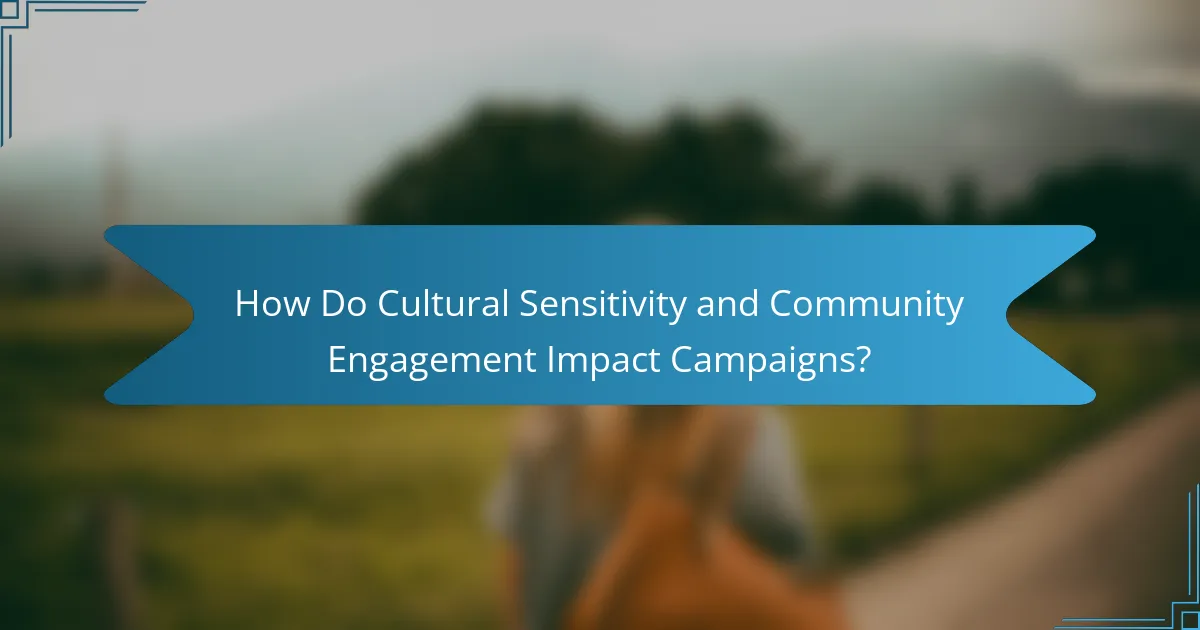
How Do Cultural Sensitivity and Community Engagement Impact Campaigns?
Cultural sensitivity and community engagement significantly enhance the effectiveness of human rights campaigns by fostering trust and ensuring that messaging resonates with diverse populations. These elements help organizations connect authentically with communities, leading to more impactful advocacy efforts.
Improved trust and participation
Building trust within communities is essential for successful human rights campaigns. When organizations demonstrate cultural sensitivity, they show respect for local values and traditions, which encourages community members to participate actively in initiatives.
Engagement strategies, such as involving local leaders and stakeholders in campaign planning, can further enhance trust. This collaborative approach often leads to higher participation rates, as individuals feel their voices are valued and heard.
Tailored messaging for diverse audiences
Effective campaigns require messaging that resonates with various cultural backgrounds. Tailoring communication to reflect the unique experiences and values of different groups ensures that the message is relevant and impactful.
For instance, using local languages and culturally appropriate symbols can significantly increase understanding and acceptance. Campaigns that consider these factors are more likely to engage diverse audiences and foster a sense of ownership over the issues being addressed.
Enhanced campaign effectiveness
Cultural sensitivity and community engagement lead to more effective campaigns by aligning objectives with the needs and concerns of the target population. Campaigns that integrate feedback from community members can adapt strategies to better address local issues.
Moreover, when campaigns are perceived as inclusive and respectful, they tend to generate broader support and mobilize resources more effectively. This can result in increased funding and partnerships, further amplifying the campaign’s reach and impact.
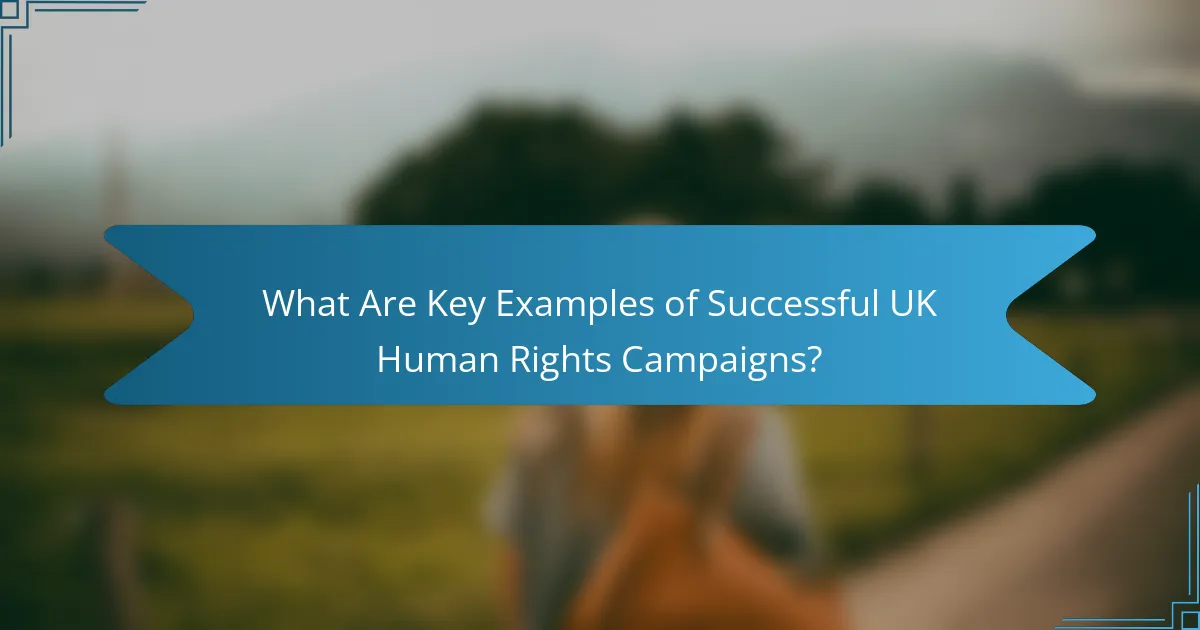
What Are Key Examples of Successful UK Human Rights Campaigns?
Successful UK human rights campaigns often focus on advocacy, community engagement, and cultural sensitivity. These campaigns have made significant impacts by addressing specific issues and mobilizing public support.
Stonewall’s [censured] advocacy
Stonewall has been a leading force in advocating for [censured] rights in the UK since its inception. The organization works to promote equality and challenge discrimination through various initiatives, including educational programs and public awareness campaigns.
One notable effort is the “Rainbow Laces” campaign, which encourages sports organizations to support [censured] inclusion. This initiative has gained traction across various sports, fostering a more inclusive environment for athletes and fans alike.
Amnesty International’s local initiatives
Amnesty International engages in numerous local initiatives aimed at protecting human rights across the UK. These initiatives often involve grassroots activism, where community members are mobilized to advocate for specific issues like refugee rights and police accountability.
For example, Amnesty’s “Write for Rights” campaign encourages individuals to write letters on behalf of prisoners of conscience. This simple act of solidarity can significantly impact the lives of those unjustly imprisoned, highlighting the power of community engagement.
Black Lives Matter UK actions
Black Lives Matter UK has been pivotal in raising awareness about racial injustice and police brutality. The movement emphasizes the need for systemic change and has organized numerous protests and campaigns to advocate for Black rights in the UK.
Key actions include the “No Justice, No Peace” protests, which have drawn thousands of participants and brought attention to issues such as racial profiling and institutional racism. These events not only mobilize public support but also foster discussions around cultural sensitivity and community engagement.
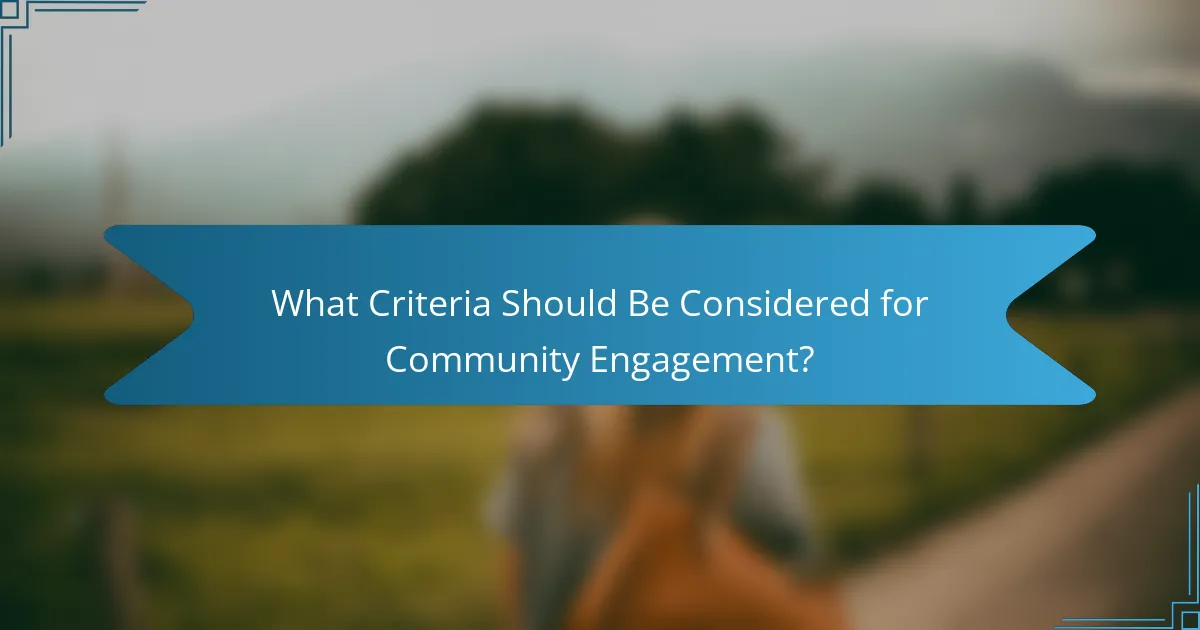
What Criteria Should Be Considered for Community Engagement?
Effective community engagement requires a thoughtful approach that considers various criteria to ensure inclusivity and responsiveness. Key factors include understanding local demographics, assessing community needs, and evaluating existing resources to foster meaningful participation.
Understanding local demographics
Understanding local demographics is crucial for tailoring engagement strategies to the specific characteristics of a community. This involves analyzing factors such as age, ethnicity, socioeconomic status, and education levels. For example, a community with a high percentage of young people may benefit from digital engagement methods, while older populations might prefer face-to-face interactions.
Utilizing census data and local surveys can provide insights into these demographics. Engaging with community leaders can also help identify unique cultural aspects that should be respected and integrated into campaigns.
Assessing community needs
Assessing community needs involves identifying the specific issues and challenges faced by residents. This can be achieved through surveys, focus groups, and public forums, allowing community members to voice their concerns and priorities. For instance, if a community is struggling with access to healthcare, campaigns can focus on health-related human rights issues.
It’s essential to prioritize needs based on urgency and impact. Engaging with local organizations can provide additional context and help ensure that the most pressing issues are addressed effectively.
Evaluating existing resources
Evaluating existing resources means taking stock of what is already available within the community to support engagement efforts. This includes identifying local organizations, funding opportunities, and volunteer networks that can assist in implementing campaigns. For example, partnerships with schools or community centers can enhance outreach efforts.
Additionally, understanding the limitations of available resources is important. Communities may face budget constraints or lack access to certain technologies, which can influence the methods used for engagement. A resource inventory can help in planning realistic and sustainable initiatives.

How Can Campaigns Measure Their Impact on Human Rights?
Campaigns can measure their impact on human rights through various methods that provide insights into effectiveness and community engagement. Key approaches include gathering participant feedback, monitoring policy changes, and analyzing media coverage to assess public perception and influence.
Surveys and feedback from participants
Surveys and participant feedback are essential tools for understanding the effectiveness of human rights campaigns. By collecting responses from those directly involved, campaigns can gauge satisfaction, identify areas for improvement, and measure perceived impact on human rights issues.
Consider using a mix of quantitative and qualitative questions to capture a comprehensive view. For instance, rating scales can quantify satisfaction, while open-ended questions allow for detailed personal experiences. Aim for a response rate of at least 20-30% to ensure data reliability.
Tracking policy changes
Monitoring policy changes is crucial for assessing the long-term impact of human rights campaigns. This involves keeping track of new legislation, amendments, or shifts in governmental stance that align with campaign objectives. Successful campaigns often lead to tangible policy outcomes that reflect their influence.
To effectively track these changes, establish a timeline of relevant policies before, during, and after the campaign. Regularly review government publications and consult with advocacy groups to stay informed about developments. This approach can help identify correlations between campaign activities and policy shifts.
Analyzing media coverage
Analyzing media coverage provides insights into public perception and the broader discourse surrounding human rights issues. By evaluating how campaigns are portrayed in the media, organizations can understand their reach and the effectiveness of their messaging.
Utilize media monitoring tools to track mentions across various platforms, including print, online, and social media. Look for trends in coverage volume and sentiment, and consider conducting a content analysis to assess the framing of issues. This can help refine future communication strategies and enhance engagement efforts.

What Are the Challenges in Implementing Human Rights Campaigns?
Implementing human rights campaigns in the UK faces several challenges, including cultural sensitivity, community engagement, and resource allocation. These factors can significantly impact the effectiveness and reach of such initiatives.
Cultural Sensitivity in Campaigns
Cultural sensitivity is crucial for the success of human rights campaigns. Understanding the diverse backgrounds and beliefs of communities helps tailor messages that resonate and avoid alienation. Campaigns that fail to consider cultural nuances risk backlash and reduced participation.
To enhance cultural sensitivity, campaigners should engage with community leaders and representatives during the planning stages. This collaboration can provide insights into local customs and values, ensuring that the campaign is respectful and relevant.
Community Engagement Strategies
Effective community engagement strategies are essential for mobilizing support for human rights campaigns. These strategies can include workshops, public forums, and social media outreach that encourage dialogue and participation. Engaging communities fosters ownership and commitment to the campaign’s goals.
Utilizing local influencers and organizations can amplify outreach efforts. For instance, partnering with schools, religious institutions, or local NGOs can help build trust and credibility, making it easier to convey important messages and gather support.
Resource Allocation and Funding
Resource allocation and funding pose significant challenges for human rights campaigns. Limited budgets can restrict the scope and impact of initiatives, making it essential to prioritize activities that yield the highest return on investment. Campaigns should focus on cost-effective strategies that maximize outreach.
Exploring diverse funding sources, such as grants, crowdfunding, and partnerships with businesses, can help secure necessary resources. Establishing clear budgets and tracking expenses ensures that funds are used efficiently, allowing campaigns to adapt and respond to emerging needs.


